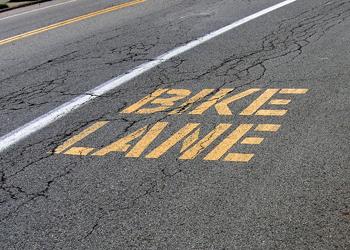GOP-backed transportation bill slashes funding for cycling, pedestrian facilities
Funding to create bike lanes is among the cuts in a Republican-sponsored transportation bill pending before the House of Representatives. (Photo by Flickr user Dan Brubaker Horst, cc-by-sa.)
Federal statistics indicate as recently as 30 years ago two-thirds of our kids biked or walked to school.
Boy, have times changed. Today, less than 13 percent of our kids walk or ride a bike to school. The Federal Safe Routes to School program was started in 2005 to try and change that.
But as the federal government wrestles with its next transportation bill, that’s a program that’s on the chopping block. Rep. Earl Blumenauer, a Democrat from Oregon, is an avid cyclist trying to stop that from happening. Blumenauer’s never brought a car to Washington, D.C., in his 15 years of service.
He rides his bike to work every day.
“It’s one of the best parts of my day,” he said.
Blumenauer said the Republican-sponsored transportation bill is the worst piece of transportation legislation he’s ever seen — and not just in the time he’s been in Congress. Essentially, it would remove the transportation enhancement element of funding. It requires funds to be reserved for pedestrian and cycling facilities.
“It would take away the transportation enhancement program option, which is the most popular program in the entire federal transportation arena,” Bluemenauer said. “It eliminates a requirement that states provide bike and pedestrian accommodation when there’s major bridge replacement. It repeals the Safe Routes to School program which has been so instrumental in trying to make sure that kids can get to school safely on their own — to make sure that there are bike lanes, that there are curb cuts, that there are sidewalks for heaven’s sakes.”
Research shows that in many communities, rush-hour happens in two waves, because so many parents are driving children to school and dropping them off. Federal Highway Administration research suggests if all our kids walked to school or rode their bikes to school, we’d add 12 billion hours of exercise time and save 160 million gallons of gas each year.
“it’s astounding when you think of the cumulative affect that would occur if children could travel safely, or just generally. A quarter of the trips in the United States, one quarter of the trips, are a mile or less,” Blumenauer said. “On trips like that, I beat my friends in a car.”
Federal funding for alternative modes of transportation has grown dramatically since it started in 1992. That year, 50 projects received $23 million in funding. Last year, 3,000 enhancement programs received $1.2 billion in funds.
Supporters of federal funding for bicyclists and walkers point out that 12 percent of our trips are made by biking and walking, yet just 1.6 percent of federal transportation money goes to cycling and pedestrian infrastructure.
“That’s a critical point, and even more of a disparity is the fact that 16 percent of the accidents are bike and pedestrians,” Blumenauer said. “So, it’s a significant portion of the mode split everyday, but it is more dangerous on average, and it gets a tenth of the resources that would be dictated if you were just trying to make people safer.”
Blumenauer said the current proposal is an assault on 20 years of progress. Fortunately, he said, the bill contains many other unreasonable provisions that will probably make this particular bill “dead on arrival.”
“But I am concerned that we have these very destructive provisions that start working their way into the process,” Blumenauer said.”I think it’s important for people to react quickly, firmly, indicate that it’s not acceptable. If everybody who cares about cycling makes their views heard, this assault will go away and we’ll get back to strengthening the partnership rather than trying to weaken it.”
